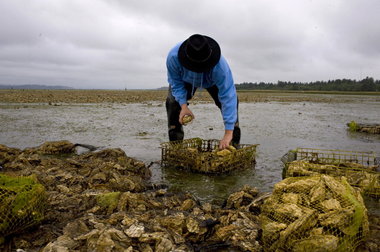Posted on OregonLive: 27 Nov 2012 — By The Associated Press

Dan Driscoll, owner of Oysterville Sea Farms, checks on the oysters in Willapa Bay. Long Beach Peninsula, in Washington’s Southwest corner. Rising ocean acidity threatens shellfish such as oysters–Beth Nakamura, The Oregonian
SEATTLE — Rising acidity levels in the oceans pose a serious threat to shellfish and other marine life, and tackling that problem in Washington state will require reducing carbon dioxide emissions, keeping polluted runoff out of marine waters, and increasing monitoring at hatcheries, a group of experts recommended Tuesday.
The panel of scientists and policy experts convened by Gov. Chris Gregoire recommended dozens of actions to combat changes to ocean chemistry detected several years ago when oyster larvae in Pacific Northwest hatcheries began dying in large numbers.
“There are ominous signals coming from the ecosystem on this issue, as ominous as anything coming from climate change,” said Jay Manning, former state ecology director who headed the panel with former Environmental Protection Agency administrator Bill Ruckelshaus.
Gregoire, who formed the group as part of a state and federal initiative to help protect the state’s $270 million shellfish industry, scheduled a news conference Tuesday to announce her new steps.
“This report really draws attention to a problem that exists internationally but that has really hit hard right here in the state of Washington,” said Jane Lubchenco, administrator of the National Oceanic and Atmospheric Administration.
The problem known as acidification is caused when oceans absorb human-generated carbon dioxide, mostly from the atmosphere and also from nutrient runoff and other sources.
Studies have shown that corrosive water has a dramatic effect on oysters, clams, and corals, and could potentially affect the broader marine food web.
Washington state is the nation’s top producer of farmed shellfish. The problem affects the industry along with consumers and anyone who has ever dug up razor clams or picked oysters on the coast, Manning said.
The panel, the first of its kind for a state, recommended 42 wide-ranging actions for consideration by the governor, who leaves office in January. It cited 18 key priorities, including developing a strategy to reduce carbon dioxide emissions and finding innovative techniques such as seaweed farming to capture and remove carbon.
Some actions would take several years, while others might take much longer. Manning said the group didn’t tally a total cost because many of the actions can be scaled, while others might not even be implemented depending on what further research shows.
Ocean acidification likely affects marine organisms to varying degrees, but research has shown those using the mineral calcium carbonate to make shells, skeletons or other body parts are more sensitive to changing sea chemistry. The organisms include oysters, clams, scallops, mussels and coral.
In February, scientists in Oregon found evidence that higher levels of carbon dioxide in the Pacific Ocean were responsible for the failure of oyster larvae to survive in 2005 at Whiskey Creek Shellfish Hatchery on Netarts Bay.
The panel said Washington’s waters are particularly vulnerable to ocean acidification because seasonal ocean upwelling brings water rich in carbon dioxide — and more acidic — up from the deep ocean toward the continental shelf.
“We’re still struggling with what we know and what we don’t know about the biological impacts. We do know a whole lot about what happens to oyster larvae,” said Richard Feely, an oceanographer at NOAA’s Pacific Marine Environmental Laboratory in Seattle and a panel member.
Scientists are learning that other organisms such as pteropods — tiny free-swimming snails that are a primary food source for salmon — are already being affected by acidification, Feely said.
More recent work has found that acidifying oceans can affect behavioral responses of some organisms, such as whether a fish will go toward or avoid a predator, he said.
“We now need to have a better understanding of how the changes are taking place at the very bases of the food chain and how those changes permeate through the food chain up to fish and birds and mammals,” Feely said.
Read this story on OregonLive.